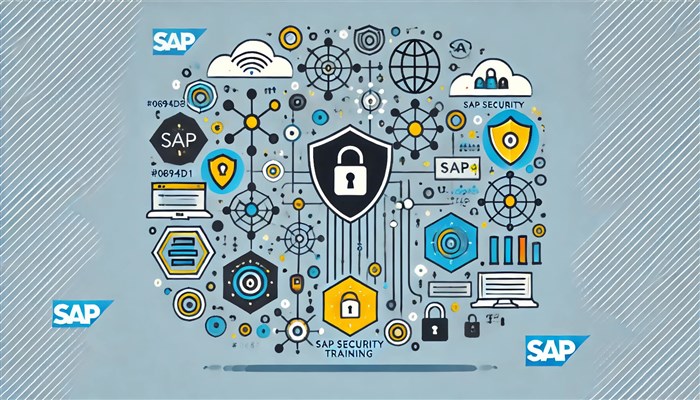
In today’s digital landscape, organizations heavily rely on enterprise resource planning (ERP) systems to manage their business processes. SAP (Systems, Applications, and Products) is one of the most widely used ERP systems globally, and with this increasing dependence comes the need for robust security measures. SAP security ensures that sensitive business data is protected from unauthorized access, and systems are compliant with industry regulations. For individuals interested in a career in SAP security, gaining the right training and certifications is essential.
This guide will walk beginners through the process of starting their SAP security training, the key areas of focus, and tips for choosing the right certification to begin with.
What is SAP Security?
SAP security encompasses a range of practices and technologies designed to protect SAP systems from security threats. It involves managing access to sensitive data, preventing unauthorized users from tampering with systems, ensuring compliance with regulations like GDPR, and maintaining system integrity.
Security in SAP is not limited to firewalls or external protections. It also includes internal measures, such as user authentication, authorization, and system protection, which play a vital role in safeguarding data and ensuring that only the right people have access to specific functionalities within SAP.
Step-by-Step Guide to Starting SAP Security Training
1. Understand the Basics of SAP
Before diving into SAP security, it’s important to have a foundational understanding of SAP itself. If you're a complete beginner, take time to learn how SAP ERP systems work. You should familiarize yourself with SAP’s structure, including its core modules, data flows, and the types of data it manages. Understanding how SAP operates will help you appreciate the importance of securing these systems.
How to Get Started:
- Enroll in an introductory SAP course, such as SAP Overview or SAP ERP Fundamentals.
- Explore SAP training platforms like SAP Learning Hub, which offer various resources to help you grasp SAP basics.
- Consider tutorials and books that explain the SAP ecosystem, covering modules like finance, human resources, and supply chain management.
2. Learn the Fundamentals of Cybersecurity
Since SAP security falls under the broader umbrella of cybersecurity, it’s crucial to have a strong foundation in cybersecurity principles. This includes learning about data protection, threat detection, identity management, encryption, and compliance frameworks.
How to Get Started:
- Take introductory courses in cybersecurity to understand concepts such as firewalls, malware, and encryption.
- Learn about the importance of protecting enterprise systems from external threats.
- Understand the role of access controls and user authentication in maintaining data security.
3. Dive into SAP Security Concepts
Once you're familiar with SAP basics and cybersecurity, it’s time to focus specifically on SAP security. SAP security training covers areas such as user authentication, authorization (role-based access control), system auditing, compliance management, and encryption.
Key topics you will encounter include:
- User Authentication: Understanding how users are authenticated within SAP systems using credentials such as passwords, single sign-on (SSO), or multi-factor authentication (MFA).
- Access Controls: Managing roles and authorizations to ensure that users only have access to the data and transactions that are relevant to their job function. This is done through role-based access control (RBAC).
- System Auditing and Monitoring: Implementing mechanisms to track system activity, detect security breaches, and identify potential vulnerabilities. Audits help ensure compliance with internal and external policies.
- Compliance Management: Ensuring that the system complies with various regulatory frameworks, such as GDPR (General Data Protection Regulation) or SOX (Sarbanes-Oxley Act).
- Data Encryption: Securing sensitive data in transit and at rest through encryption technologies.
How to Get Started:
- Enroll in SAP security-specific courses such as “SAP Security Fundamentals” or “SAP Authorization Concepts.”
- Access SAP security documentation, which covers key security configurations and best practices.
- Get hands-on experience with SAP’s security administration tools, such as SAP GRC (Governance, Risk, and Compliance).
4. Explore Hands-On SAP Security Experience
While theoretical knowledge is important, hands-on experience with SAP systems is critical. Understanding the practical application of security measures, such as setting up access controls or conducting system audits, helps solidify your knowledge.
How to Get Started:
- Set up a demo SAP system or use a sandbox environment where you can practice SAP security configurations without impacting live systems.
- Engage in exercises that allow you to configure user roles, audit logs, and access permissions.
- Practice using SAP GRC tools to manage risks and ensure compliance in a simulated environment.
5. Choose the Right Certification
As a beginner, choosing the right certification is crucial for establishing a career in SAP security. Certification provides validation of your expertise and helps you stand out in a competitive job market. There are several certifications to consider based on your experience and career goals:
Entry-Level Certifications
- SAP Certified Technology Associate – SAP System Security Architect: This certification is ideal for those starting their journey in SAP security. It covers fundamental topics like system protection, access control, and audit management.
- SAP Certified Technology Associate – SAP Authorization and Auditing: Focuses on configuring roles and authorizations, managing user access, and ensuring system compliance through auditing.
Advanced Certifications
- SAP Certified Technology Professional – System Security Architect: For professionals with more experience, this certification delves into more advanced topics, such as securing SAP HANA and hybrid cloud environments.
How to Choose the Right Certification:
- For beginners, start with the SAP Certified Technology Associate – SAP System Security Architect certification. It provides a comprehensive overview of SAP security, and the skills you acquire will be applicable in various industries.
- If your focus is on managing user roles and access, the SAP Authorization and Auditing certification is ideal.
- Consider your career goals and the specific areas of SAP security that interest you the most, such as cloud security or compliance.
6. Study Resources and Exam Preparation
Preparing for your SAP security certification exam requires a combination of study resources, hands-on practice, and mock exams. Utilize the following resources to increase your chances of passing:
- SAP Learning Hub: SAP’s official learning platform offers a wide range of resources for SAP security training, including study guides, tutorials, and webinars.
- Practice Exams: Take advantage of sample questions and practice exams to familiarize yourself with the format and types of questions that may appear on the certification exam.
- Online Forums and Communities: Join SAP security communities and forums to discuss exam strategies and share study resources with others who are preparing for the same certification.
Key Areas of Focus in SAP Security
Let’s dive deeper into some of the key areas of focus in SAP security that you will encounter during your training:
- User Authentication: This involves verifying the identity of users accessing SAP systems. Techniques such as password policies, SSO, and MFA are critical in preventing unauthorized access.
- Access Controls: Configuring user roles and permissions ensures that users can only access the data and perform the tasks relevant to their role. RBAC is a key concept in this area.
- System Auditing: SAP systems generate logs of all activities. Auditing involves analyzing these logs to detect irregularities, such as unauthorized access attempts or suspicious system changes.
- Data Protection: SAP security includes mechanisms to encrypt sensitive data and ensure compliance with data protection laws, ensuring the integrity and confidentiality of critical business data.
Conclusion
Starting your journey in SAP security may seem daunting at first, but with a structured training approach, you can build a solid foundation for a rewarding career. By understanding the basics of SAP, gaining hands-on experience, and choosing the right certification, you will be well on your way to becoming an SAP security professional from Koenig Solutions. With the right mix of technical skills and certifications, you'll not only protect critical business data but also position yourself as a valuable asset in today's digital world.







COMMENT